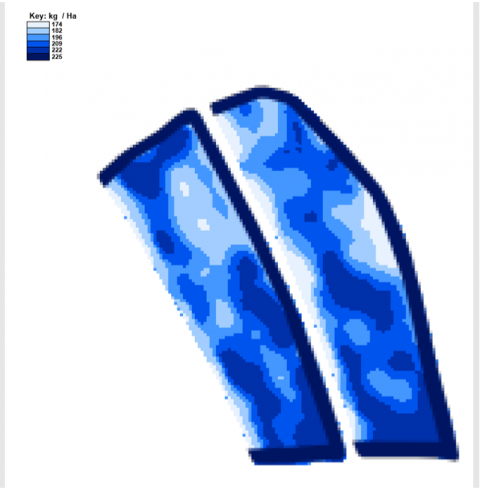Pantyderi Harvest Report 2020- Sowing spring barley using variable seed rate
Following soil mapping and creating management zones within fields, two adjacent fields of similar size and soil type variation were selected for a variable seed rate trial with spring barley, variety Kelim. One field was sown at a flat rate of 185kg/ha and in the other, the poorer soil type or problem areas of the field, like turning headlands, received higher seed rates according to the key in Fig 1, with the aim of increasing overall crop yields.
Fig 1: Variable seed rate maps for the two adjacent trial fields. The field to the right, Waun Ganol, was the variable rate sown field.
Both fields were drilled by the same contractor and received the same management inputs over the summer.
Plant head counts were carried out on 25 July across the two fields.
Fig 2: Location of plant head counts
Table 1: Plant head counts
Plant head counts were 18% higher on average in the variable rate (VR) sown field with less variation demonstrated across the field than for the flat rate sown field.
Crop health status at the time of the head count showed that the VR sown field was suffering from stress (Fig 3), subsequently suggested to be either due to disease or a nutrient deficiency.
Fig 3: Waun ganol (variable rate field)
Fig 4: Neuadd (flat rate field)
The two fields were harvested in the second week of September on the same day, at a moisture content of 14-15% with grain and straw yields presented in Table 2.
|
|
Waun Ganol Variable rate |
Neuadd Flat rate |
|
Total field area ha |
4.7 |
4.2 |
|
Barley total t |
25.12 |
24.7 |
|
Barley t/ha |
5.34 |
5.88 |
|
Straw bales /ha |
15.53 |
15.95 |
Table 2: Harvested barley and straw yields
The apparent yield advantage to the VR field recorded from plant head counts did not translate into differences in combinable yields, with little difference demonstrated between the two fields.
Comparing the YEN Grain Nutrient report for the two fields, levels of phosphate and potash were lower for Waun Ganol (0.3 and 0.42%) compared to Neuadd (0.36 and 0.47%) although they are not classed as limiting. Boron and manganese were low in both fields with the only notable difference being a much higher molybdenum level recorded for the Neuadd grain sample (see separate YEN Grain Nutrient report).
It is planned to carry out another VR spring barley seed trial in 2021 and lay it out so the flat and VR sown crops are both in the same field.

